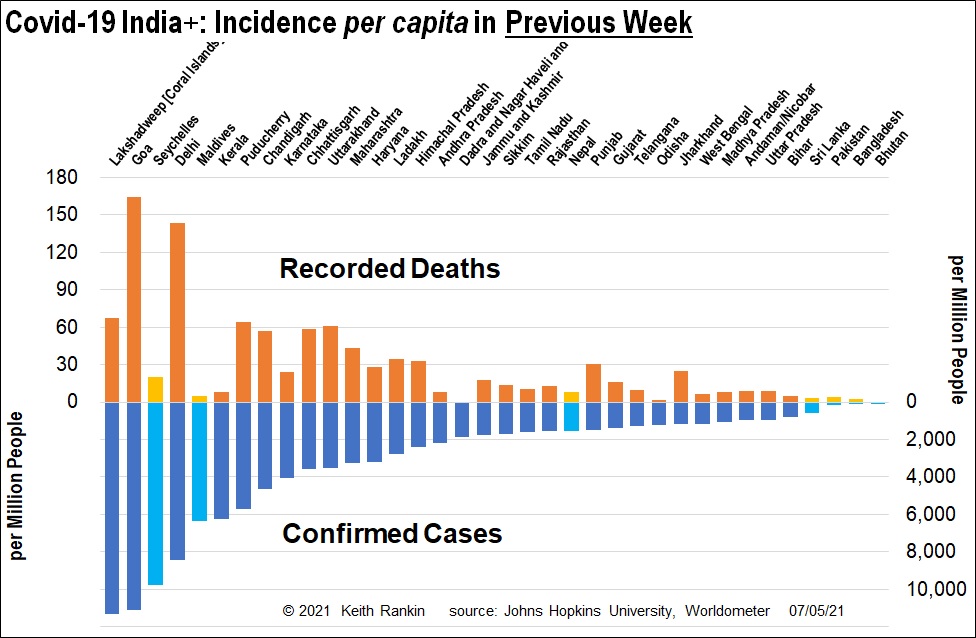Analysis by Keith Rankin.

India’s Covid19 outbreak is still predominantly in the more prosperous cities, mainly in the west and far north of that country. And it is in the domestic coastal and mountain tourist destinations. The data continue to show the provinces which represent the stereotypic poverty and crowdedness – the Ganges provinces of Uttar Pradesh, Bihar and West Bengal – have among the lowest per capita rates of Covid19. Only the provinces of the far northeast, to the north and east of Bangladesh, are less affected than the Ganges provinces.
That is not to say that the available statistics capture the whole story; and it is not to say that the growth rates (from a low base) in the Ganges provinces are not high. Nevertheless, the statistics continue to support the view that the principal vectors of Covid19 are rich and middle class people.
It is useful to think of the United States of India, or the Indian Union. Each state compiles its own statistics, and there are clear procedural differences, as there are in Europe. For example, Kerala has a high reported infection rate, but a low recorded death rate. Kerala almost certainly undercounts deaths, but not cases. On the other hand, Delhi and Uttar Pradesh almost certainly undercount cases more than they undercount deaths.
We have to be careful about suggesting that large relatively poor countries – such as India – officially understate their actual data more than, say, western countries do. Certainly, counting anywhere becomes overwhelmed when numbers are very high. In March to May last year, Sweden’s case undercount was notorious, as was Netherlands’ death undercount.

Today’s second chart removes India’s low incidence northeast and adds India’s neighbour countries.
Immediately we see that the Maldives and the Seychelles have had Covid19 infection rates in the last week comparable to those of India’s worst affected states. (Indeed, in the last week, Seychelles and Maldives had the highest national infection rates in the whole world.) The only viable conclusion is that prosperous Indians are decamping from Delhi and Mumbai, and taking Covid19 with them.
(The Maldives are caught up in a major political crisis today, with the attempted assassination of their most senior politician. I wonder if this assassination attempt makes our news. Last week, the stampede in Israel that killed about 50 people didn’t even make it on the TV1 6pm news, despite it having been the lead story on Al Jazeera.)
The next story is that Nepal’s Covid19 data is comparable with that of India as a whole, and is growing fast. Nepal’s situation follows that of India’s getaway Himalaya states: Chandigarh, Uttarakhand, and Himachal Pradesh. Nepal’s death rates will almost certainly surge over the next few weeks.
The other neighbour countries also shed light on India. Sri Lanka’s statistics look quite good, with cases being about 200 times deaths. There is no reason to believe that Sri Lanka has a bigger undercount than other countries. Pakistan and Bangladesh have very low rates compared to India. Both have large absolute numbers of course – they are very populated countries – and have had increases in April, when India’s cases increased dramatically. But still much lower than India. Bangladesh’s data suggest that the data for West Bengal may not be dramatically inaccurate.
Finally, we may note Bhutan. This is a country that today’s ‘left’ laud, much as in the 1960s the left fringe cited Albania as a role model. It is one of the world’s weird countries, as is Turkmenistan and North Korea. While official data at least exists in Bhutan – unlike Turkmenistan – my hunch is that the actual situation there is at least as bad as in neighbouring Assam, if not Sikkim.
Comparing India with Europe
Checking total (accumulated) death rates from Covid19, Europe substantially ‘outperforms’ the rest of the world. Of the 12 countries with the most deaths per capita, all are countries in Europe either in the European Union or bordering it. Of the 25 worst countries in the world, only four (Brazil, Peru, USA, and Mexico) are not in or adjacent to the European Union. Other European Union countries are in the top 50: Sweden is 33rd, Switzerland is 35th, Germany is 44th, undercounting Netherlands at 45. India is ranked 110, but is of course rising up the ranks. New Zealand is 194th.
Worst is Hungary, where three in one thousand people have died, equivalent to 15,000 in New Zealand. France is 23rd, where 1.6 in a thousand have died, equivalent to 8,000 deaths in New Zealand.
Looking at the last week, the ten worst countries for recorded deaths are (in order): Wallis and Futuna (between Fiji and Samoa), Uruguay, North Macedonia (former Yugoslav republic), Hungary, Bermuda (where our top America’s Cup sailors were last week), Paraguay, Bosnia and Herzegovina, Croatia, Brazil, and Bulgaria. India is 53rd.
And, the ten worst countries for reported infections are (in order): Seychelles, Maldives, Bahrain, Uruguay, Cabo Verde, Sweden, Argentina, Lithuania, Netherlands, Costa Rica. None of these are stereotype ‘third world’ countries. India is 26th.








